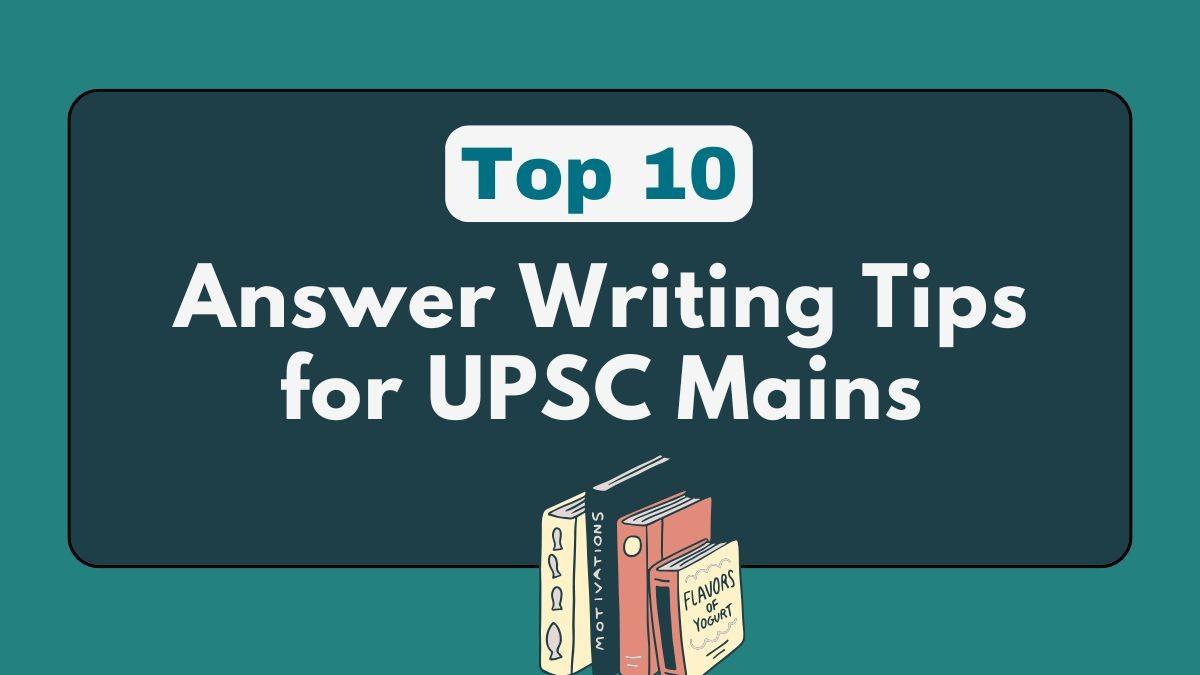


Want to score high in UPSC Mains? Read top 10 answer writing tips to improve structure, clarity, time management, and content quality in your answers.
The UPSC Civil Services Mains Examination is a test not just of your knowledge but also your ability to express ideas clearly and concisely. Thousands of aspirants clear Prelims every year, but only a few succeed in Mains and one of the key differentiators is answer writing.
To improve UPSC Mains answer writing, structure your answers with an introduction, body, and conclusion (IBC format), and use subheadings and bullet points for clarity. Carefully analyze the question to understand keywords like “discuss” or “critically evaluate” and allocate time wisely, aiming for about 7 minutes for 10-mark and 11 minutes for 15-mark questions. To score high, substantiate your points with relevant examples, current affairs, and data, and include diagrams or flowcharts to visually represent complex information.
The UPSC Mains exam comprises 9 subjective papers, and unlike Prelims, success here depends heavily on how well you present your knowledge. Even if you know the answer, poor structure or lack of clarity can cost you valuable marks.
The UPSC examiner is looking for:
In this blog, we share the top 10 answer writing tips for UPSC Mains to help you structure your responses better, improve content quality, and maximize your scores in General Studies and optional papers.
Before writing, carefully read and analyze the question. Identify directive keywords like analyze, discuss, or evaluate, and break down multi-part queries. Understanding exactly what’s being asked ensures your answer stays relevant, focused, and structured- helping you avoid unnecessary information and directly address the examiner’s expectations. Before jumping into writing, spend 1-2 minutes analyzing the question:
Always tailor your answer to what the question specifically asks. Avoid writing generic or irrelevant content. Focus on addressing all parts of the question directly and concisely, ensuring your response remains accurate, purposeful, and within the scope of the topic. One of the biggest mistakes aspirants make is going off-topic. Your answer should directly address what is being asked.
For example:
Maintain a clear structure with a brief introduction, a well-organized body covering all key points, and a concise conclusion. This enhances readability, ensures logical flow, and helps the examiner quickly grasp your arguments, improving the overall impact of your answer. Structure is crucial for readability and flow.
Incorporate diagrams, flowcharts, and maps to present complex information clearly and concisely. Visual aids make your answers more engaging, help in better retention, and can fetch extra marks by showcasing conceptual clarity and effective presentation skills, especially in geography and environment topics. Visuals break monotony and help convey more information in less space.
Use subject-specific keywords and terminologies to demonstrate conceptual clarity and depth of understanding. Including relevant terms, constitutional articles, committee names, or economic indicators makes your answers more authoritative and aligned with UPSC expectations, improving both precision and impact. Using subject-specific terms shows depth of understanding. For example:
Showcase balanced and multi-dimensional perspectives by addressing social, economic, political, and ethical angles. Avoid one-sided arguments and support your views with examples or data. A well-rounded answer reflects maturity, critical thinking, and aligns with UPSC’s preference for objective analysis. Avoid being biased in your answers. UPSC appreciates objectivity and balanced arguments.
Manage your time wisely during the exam by allocating fixed minutes per question. Don’t dwell too long on any single answer. The UPSC time management tips improves speed, ensures you attempt all questions, and helps maintain consistency throughout the paper.
You have around 7 minutes per 10-mark question and 11 minutes for 15-mark questions.
Clear handwriting and neat presentation make your answers easy to read and understand. Use proper spacing, bullet points, and underlining to highlight key points. A well-organized answer sheet creates a positive impression and can influence the examiner’s evaluation positively.
No matter how brilliant your content is, poor handwriting and cluttered pages can ruin your impression.
Enhance your answers by quoting relevant reports, committee recommendations, and authentic data. References like NITI Aayog, ARC reports, or Economic Survey add credibility and depth, showing awareness of real-world developments and strengthening your argument with factual support. Enrich your answers with authentic data and references, but only where relevant.
Daily answer writing builds clarity, speed, and confidence. Regular practice helps you master structuring, articulation, and time management. Use previous year questions or join a test series to simulate exam conditions and continuously refine your writing style for better performance.
You can’t master answer writing overnight. Regular practice is the only way to improve.
To get a high score in the UPSC mains Essay and Ethics papers, you must advance from a simple presentation of facts and demonstrate intellectual clarity, maturity, and reliable insight. UPSC Topper’s strategies emphasize a balanced, well-structured, and example-rich approach that reflects administrative aptitude.
The UPSC Mains is not just about what you write, but how you write it. Consistency, clarity, and structure are your best friends in this journey. These top 10 answer writing tips for UPSC Mains will help you develop a writing style that resonates with the examiners and boosts your scores significantly.
